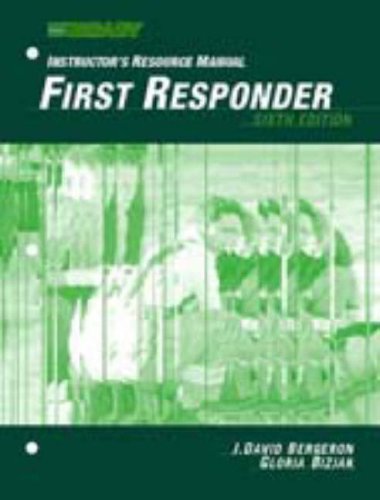Instructors Resource Manual - Softcover

"synopsis" may belong to another edition of this title.
The July/August 1994 issue of RESCUE-EMS Magazine described the plans of the National EMS Education and Practice Blueprint Project Task Force. This Blueprint provided outlines of the EMS system programs, including one for First Responder. The National Association of EMS Educators (NAEMSE) has studied the strengths and weaknesses in the National Standard Curriculum since EMS systems have initiated the Blueprint programs. The winter 1999 newsletter Domain explains the latest projections for EMS programs. These projections have been incorporated into this First Responder text and the supplemental instructor and student materials. The text also follows the guidelines set by the U.S. Department of Transportation (DOT) National Standard Curriculum.
Using these projections and guidelines, physicians, curriculum designers, instructors, and emergency care providers have designed First Responder courses to meet training needs in their communities. While all First Responder courses meet the same National Standard Curriculum objectives, jurisdictions may present additional prerequisites or require that some prerequisites be met before enrolling in the course. Emergency care procedures, for the most part, remain the same from EMS system to EMS system. However, many EMS programs may require completion of American Heart Association (AHA) CPR, or basic life support, before entering a First Responder program. While CPR guidelines are undergoing changes for the layperson, this textbook includes the most recent AHA guidelines for the emergency care provider at the time of printing. This new edition has removed the AED procedures from the appendix and has included them in the CPR chapters. AED has become an important part of basic life support, and many public facilities are beginning to place them on the premises and train their personnel in their use.
The other appendices, including Determining Blood Pressure, Breathing Aids and Oxygen Therapy, Pharmacology, Swimming and Diving Accidents, and Stress Management are there to meet the varying needs of jurisdictions throughout the country. A new appendix, First Responder Roles and Responsibilities, defines the roles and responsibilities of each level of emergency care: First Responder, EMT Basic, and EMT Paramedic. The chart shows the overlapping roles of the care providers as they respond with actions and interact with each other through the phases of an emergency and carry out their roles in the EMS system.
One of the most critical advances in emergency care is the use of personal protection, or barrier devices, against infectious diseases. More effective barrier devices have been designed, and it is important that First Responders understand their protective abilities and use them appropriately. The incidence of infection from infectious diseases, such as hepatitis, tuberculosis, and the HIV virus, remains low in emergency care providers, but it can only continue to be minimal if emergency care providers continue to use barrier devices consistently and correctly. THE LEARNING PACKAGE
Instructors will want to use instructional methods and students will want to be aware of learning techniques that enable learning. The First Responder textbook, the CD-ROM, the Workbook, and the Instructor's Resource Manual provide ideas for instruction and information and activities for learning. These ideas and activities are based on the experiences and suggestions of emergency care instructors and providers, EMS system committees, curriculum designers with backgrounds in emergency care, physicians and other medical personnel, and industry and the military involved in safety training. The Instructor's Resource Manual includes the DOT objectives and unit outlines that correlate with the textbook; the Student Workbook includes thought-provoking questions and activities that relate to real-life field experiences.
Additional features in this edition are the database flow diagrams and the injury or medical mini-flow assessment and care charts. These diagrams condense printed information into easy-to-follow visual diagrams that provide an instant review of material. The flow charts guide the First Responder student through the steps of assessment, care, and decision making. While many flow diagrams are provided, not all emergency scenarios are represented by them. Students will find that by using the basic design of the mini-flow assessment and care charts, they can design their own flow diagrams for other emergencies, use them for review, and apply the steps quickly as they practice skills procedures during training and use them on actual emergency care situations. The database flow diagrams are an excellent review resource.
Though many First Responder classes are taught in the traditional classroom by one instructor, many training programs are implementing major changes in teaching and learning, such as:
Using telecommunications and technology Using multiple instructors and team-teaching techniques Moving training from "seat-time" to competency, or outcomes Making traditional academic calendars (semesters) or forms of synchronous delivery obsolete Implementing instructional roles that reflect new modes of course development and delivery
Regardless of the mode of delivery, First Responder instructors and students can anticipate an exciting and interesting training course that provides all the necessary preparation for caring and care-giving field providers. Take full advantage of all the materials provided, try different teaching and learning methods, and participate in the suggested activities for a new adventure in learning.
J. David Bergeron and Gloria Bizjak
"About this title" may belong to another edition of this title.
- PublisherPearson Professional Education
- Publication date2001
- ISBN 10 0130324825
- ISBN 13 9780130324825
- BindingPaperback
- Edition number6
(No Available Copies)
Search Books: Create a WantIf you know the book but cannot find it on AbeBooks, we can automatically search for it on your behalf as new inventory is added. If it is added to AbeBooks by one of our member booksellers, we will notify you!
Create a Want